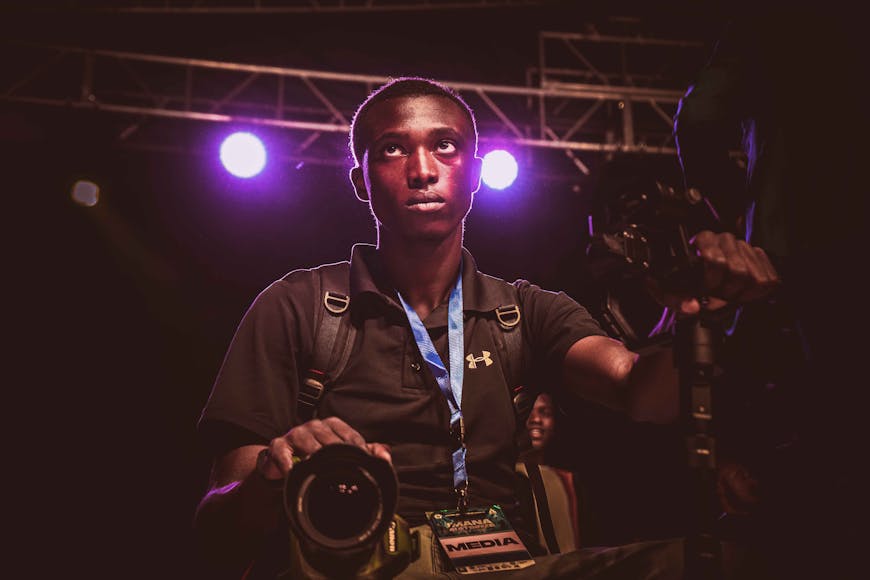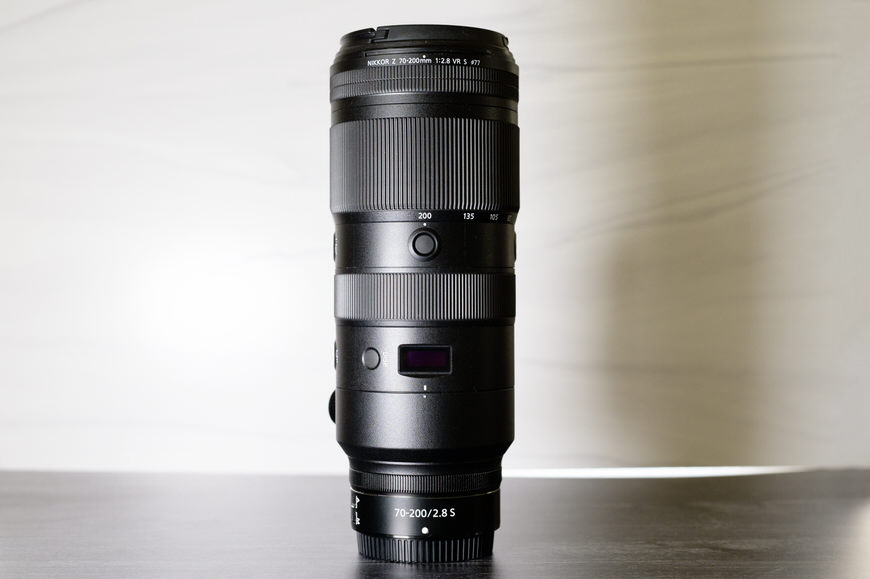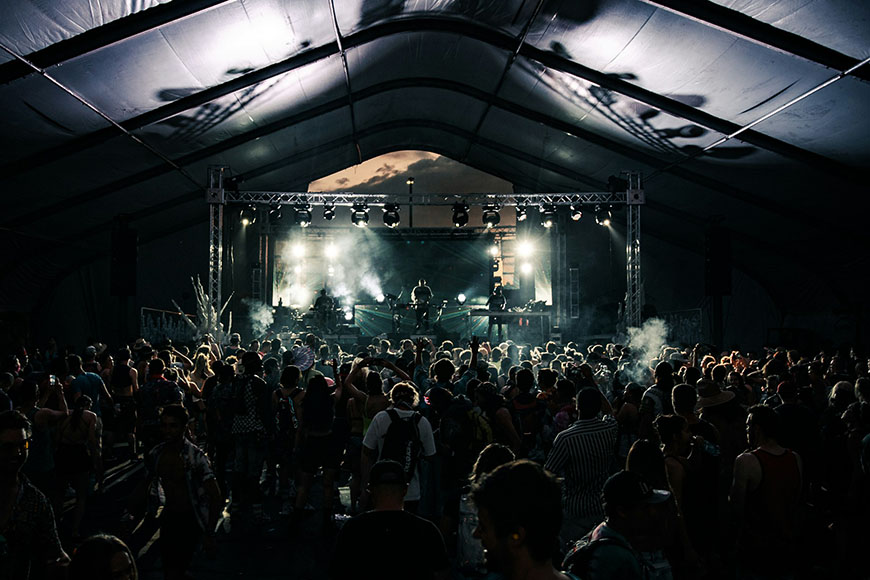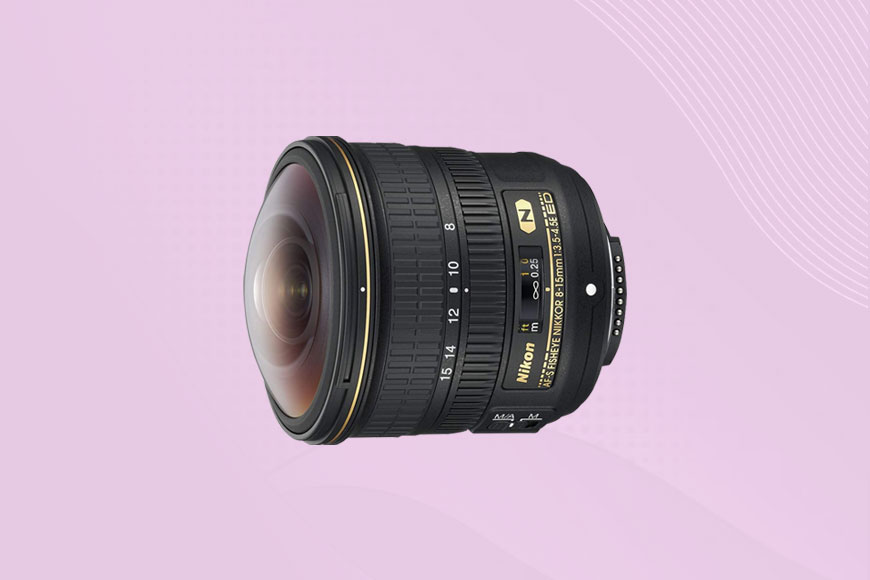
This guide will help you find the best lenses for concert photography.
Shooting concerts is a lot of fun, but you need particular equipment to be able to do it well. Foremost is your choice of lens.
Below, we’ll look at a variety of lenses that suit different venue types and shooting styles.
We’ll explore their specifications and the particular features they have that make them ideal for the job.
Note: our default in this article will be the Nikon Z system, but links to the other main brands will be included in each section.
Without further ado, let’s get this show on the road.
What Are the Best Lenses for Concert Photography in 2024?
24-70mm f/2.8 (Best All-Around Concert Photography Lens)
Credit: Steve Vansak
- Versatile zoom lens
- High-quality glass
- Wide aperture
- Good low-light performance
- Tend to be quite heavy and bulky
- Can be relatively expensive
- Limited reach
If you can afford only one lens, this is the one to start with. It’s a great all-round lens for any situation, including shooting concerts.
Every manufacturer makes a professional lens of this spec, and they generally provide the best balance of speed, range, and quality that you’ll find.
With one of these zoom lenses, you get a fast aperture that will let in enough light to illuminate the space and also allow you to use high shutter speeds to freeze the action.
And, you get a versatile focal length that will help you get both wider shots that give a bit of context and close-up shots of the performers.
Nikon FX [Amazon | B&H] | Nikon DX [Amazon | B&H] | Canon EF [Amazon | B&H] | Canon APS-C [Amazon | B&H] | Canon RF [Amazon | B&H] | Sony FE [Amazon | B&H] | Sony E [Amazon | B&H] | Fujifilm [Amazon | B&H] | Micro Four-Thirds [Amazon | B&H]
70-200mm f/2.8 (Best Concert Photography Lens for Larger Venues)

Credit: Steve Vansak
- Great reach
- High-quality optics
- Versatile
- Fast aperture
- Normally expensive
- Cumbersome
- Limiting in small venues
As a concert or music photographer, this is the second lens you should buy after the 24-70mm.
With this and a 70-200mm, you can cover nearly anything that comes your way.
You can get really close to the action with this kind of focal range, and when shooting bigger venues or when having to shoot from the back, this is the only lens that will make your job possible.
In those circumstances, the 70mm will get you your contextual shots, and the 200mm will help you with the close-ups.
As with the lens above, with an aperture of f/2.8, you’ll be fine in low light.
There aren’t many exact equivalents for APS-C shooters, but the nearest equivalents are in the links below.
Nikon FX [Amazon | B&H] | Nikon DX [Amazon | B&H] | Canon EF [Amazon | B&H] | Canon APS-C [Amazon | B&H] | Canon RF [Amazon | B&H] | Sony FE [Amazon | B&H] | Sony APS-C [Use the Canon APS-C with a converter] | Fujifilm [Amazon | B&H] | Micro Four-Thirds [Amazon | B&H]
14-24mm f/2.8 (Best Front-of-Stage Concert Photography Lens)

Credit: Jesse La Plante
- Encourages creativity
- Wide perspective
- Good for contextual shots
- Good for creating drama and scale
- Limited reach
- Typically bulky and heavy
- Can produce distorted images
This kind of focal range is particularly useful in cramped, smaller venues and for shooting directly in front of the stage.
That wide-angle view means that you can often fit the whole of a performer or an entire band into one shot.
As a live music photographer, that makes the 14-24mm a valuable tool to have.
Because of their perspective and the distortion they can introduce, you can often use these lenses for more creative and dramatic compositions.
You can emphasize a performer’s stage presence, the scale and energy of the concert, or the scale of the space.
And, that f/2.8 aperture gives you excellent low-light performance.
Nikon FX [Amazon | B&H] | Nikon DX [Amazon] | Canon EF [Amazon | B&H] | Canon APS-C [Amazon | B&H] | Canon RF [Amazon | B&H] Sony FE [Amazon | B&H] | Sony APS-C [Amazon | B&H] | Fujifilm [Amazon | B&H] | Micro Four-Thirds [Amazon | B&H]
35mm f/1.8 (Best Low-Light Prime for Smaller Venues)

Credit: Mark Condon
- Relatively compact
- Natural perspective
- Fast aperture
- Great image quality
- Need to take care with depth of field
- Limited reach
For those who shoot smaller shows or venues that are more dimly lit, I would recommend including a 35mm f/1.8 or 50mm f/1.8 in your kit.
The right focal length will depend on the type of venue you’re working in. 35mm for smaller venues may be best, but you also need to consider how tall the stage is. If it’s high, a 50mm could be better.
35mm, though, is known as the storytelling lens, and it also fills that role during concerts.
It gives you a natural, human-eye perspective that allows you to capture the performers and some of their environment, plus the crowd.
35mm primes are generally small and light, so they’re easy to carry around. They’re also built well, both physically and optically.
That wide aperture is also fantastic in low light. You just need to be careful if you shoot wide open, though, as it can be hard to keep subjects in focus.
Nikon FX [Amazon | B&H] | Nikon DX [Amazon | B&H] | Canon EF [Amazon | B&H] | Canon APS-C [Amazon | B&H] | Canon RF [Amazon | B&H] | Sony FE [Amazon | B&H] | Sony APS-C [Amazon | B&H] | Fujifilm [Amazon | B&H] | Micro Four-Thirds [Amazon | B&H]
50mm f/1.8 (Best Low-Light Prime for Taller Stages)

Credit: Andy Day
- Robust
- Compact and lightweight
- Good reach for tall stages
- Excellent low-light capabilities
- Limited compositions
- Limited reach
Sometimes, you get to a venue where the stage is tall, and that means you need more reach. Otherwise, the performers and especially their faces will seem too far away in your images.
That’s where a low-light prime 50mm comes in.
It’s wide enough to let you get upper body shots of artists and long enough to let you focus in on their faces or other details.
You can even, depending on the size of the venue, fit in some more contextual elements.
A 50mm can also be useful for taking backstage portraits of artists.
Like with the 35mm above, these primes are often rugged yet lightweight and compact, and you need to watch out for the same issues with depth of field.
You need to be careful to keep everything in focus if shooting wide open.
Nikon FX [Amazon | B&H] | Nikon DX [Amazon | B&H] | Canon EF [Amazon | B&H] | Canon APS-C [Amazon | B&H] | Canon RF [Amazon | B&H] | Sony FE [Amazon | B&H] | Sony APS-C [Amazon | B&H] | Fujifilm [Amazon | B&H] | Micro Four-Thirds [Amazon | B&H]
Fisheye Zoom (Best Specialty Lens for Concert Photography)
- Fun to use
- Can emphasize scale of venue or size of crowd
- Compact
- Encourages creativity
- Can lead to chaotic compositions
- Image distortion
Fisheye lenses are fun to mess around with, especially in the playful atmosphere of a concert.
But you should be aware that the strengths of a lens like this are also its weaknesses.
The wide field of view it gives you can emphasize the scale of a venue or the size of a crowd, but it can also make it hard to compose images with a focal point.
The distortion the lens creates can lead to some really interesting, creative, dynamic compositions, but if used without intention (or sometimes due to factors outside your control), it can lead to images that just look like a mess.
Like all specialty lenses, a fisheye lens shouldn’t be used as a main lens for concert and music photography but rather as something to use for fun and to create something unique out of.
You should note that there’s no Nikon Z version of this kind of lens. The link above is Nikon FX (which is why it’s not included below).
There’s also no Sony equivalent to that Nikon FX lens, although there are a couple of manual-focus primes.
Canon EF [Amazon | B&H] | Canon APS-C [Amazon | B&H] | Nikon DX [Amazon | B&H] | Micro Four-Thirds [Amazon | B&H]
What to Look for in a Concert Photography Lens

Credit: Colin Iloyd
Fast aperture
A fast aperture, typically f/2.8 or wider, is crucial for shooting concerts, especially in low-light environments.
It allows more light to reach the camera sensor, enabling faster shutter speeds to freeze motion and reduce the risk of blur.
Added to that, a wide aperture creates a shallow depth of field, helping to isolate subjects from distracting backgrounds.
Versatile Focal Length
If you have two camera bodies, this is less of an issue, as you can easily swap between cameras with different lenses.
However, you do need to make sure they’re the right focal length for the kind of situations you’ll be in.
If you have one camera, choose a versatile focal range that suits various shooting situations.
A zoom lens with a range of focal lengths, such as 24-70mm or 70-200mm, gives you the flexibility to capture wide-angle shots of the stage, shots of the performers, and also close-up details without needing to change lenses frequently.
This makes it a valuable addition to a music photography kit.
Image Stabilization (IS)
Image stabilization is essential for handheld shooting, especially when using telephoto lenses or when shooting in low-light environments that are the hunting ground of the concert photographer.
IS helps reduce the effects of camera shake, resulting in sharper images, and can also help you get sharp images if you have to use slower shutter speeds.
Fast Autofocus
When you’re shooting concerts or music photography, you need to be able to react quickly.
Concerts often involve fast-paced action and erratic movements, so a lens with fast and accurate autofocus capabilities is essential.
Look for lenses with silent and responsive autofocus motors that can quickly lock onto subjects to make sure you don’t miss crucial moments.
The better your autofocus, the more shots you’ll get. When photographing concerts, you need to maximize your shots.
If you’re shooting bands, you normally only have three songs to get your shots. If you’re shooting classical music, you may only be able to shoot during the louder parts.
Durable Construction
As most music photographers know, you need a robust kit for photographing concerts.
You might need to navigate jostling crowds, and some of those people might be holding drinks. Someone might crowd-surf onto you.
Make sure your lenses are weather-sealed and have good build quality to withstand whatever a concert throws at them.
What Focal Length Is Best for Concert Photography?
Typically, the best focal length for shooting concerts falls within the range of 24mm to 200mm, depending on the size of the venue, the distance from the stage you’ll need to shoot from, and the type of shots you want to capture.
Wide-angle lenses (10-35mm) are great for capturing the atmosphere of the concert, including the crowd, stage setup, and venue architecture.
They’re also ideal for immersive shots that convey the overall vibe of the event.
But, they may distort subjects when used up close, so be selective about when you use them.
Lenses between 35mm and 85mm offer concert photographers versatility and are suitable for capturing a variety of compositions.
You can get shots of the performers and also wider scenes that include the stage and audience.
They strike a nice balance between capturing the action on stage and providing context for the concert environment.
If you’re shooting at the upper end of this range, though, you don’t want to be too close to the stage.
Telephoto zoom lenses (85-200mm) are needed if you’re shooting from a distance, which is common in larger venues or when you don’t have access close to the stage.
Longer telephoto lenses are particularly useful for shooting from the sides of the venue, for individual artist shots, and right from the back of the venue for contextual shots.
The Best Lenses for Concert Photography by Brand

Credit: Antony Trivet
Here is a selection of the lenses you should have in your kit bag, according to brand.
The Best Canon Lenses for Concert Photography
- Sigma 24-70mm f/2.8 DG OS HSM Art Lens for Canon [Amazon | B&H]
- Canon EF 24-70mm f/2.8L II USM [Amazon | B&H]
- Canon EF 70-200mm f/2.8L IS III USM [Amazon | B&H]
- Canon EF 16-35mm f/2.8L III USM [Amazon | B&H]
- Canon EF 50mm f/1.8 STM [Amazon | B&H]
The Best Nikon Lenses for Concert Photography
- Nikon AF-S NIKKOR 24-70mm f/2.8E ED VR [Amazon | B&H]
- Nikon AF-S NIKKOR 70-200mm f/2.8E FL ED VR [Amazon | B&H]
- Nikon AF-S NIKKOR 14-24mm f/2.8G ED [Amazon | B&H]
- Nikon AF-S NIKKOR 50mm f/1.8G [Amazon | B&H]
The Best Sony Lenses for Concert Photography
The Best Fujifilm Lenses for Concert Photography
The Best Micro Four-Thirds Lenses for Concert Photography
- Panasonic LUMIX G 12-35mm F2.8 [Amazon | B&H]
- Olympus M.Zuiko Digital ED 40-150mm f/2.8 PRO [Amazon | B&H]
- Panasonic Lumix G Leica DG Nocticron 42.5mm f/1.2 [Amazon | B&H]
FAQs about the Best Lenses for Concert Photography
What lenses do concert photographers use?
Generally, they use robust lenses with versatile focal lengths, fast apertures and autofocus, and in-built image stabilization.
What is the best budget lens for concert photography?
Most manufacturers make budget, wide-aperture versions of their prime lenses.
You’ll most likely want to get a 35mm.
Is f/4 fast enough for concert photography?
If the concert is very well-lit, yes.
As a rule, though, it won’t be fast enough. You’ll need slower shutter speeds, so your images will blur, or you’ll need to boost your ISO, resulting in noise.
The ideal aperture is f/2.8.
Credit : Source Post







